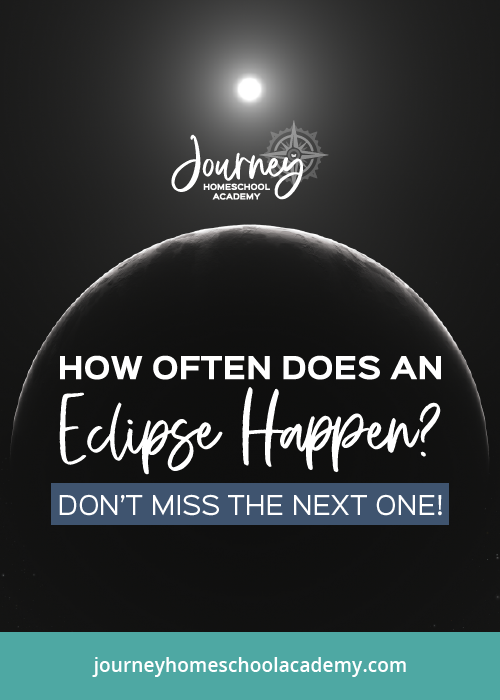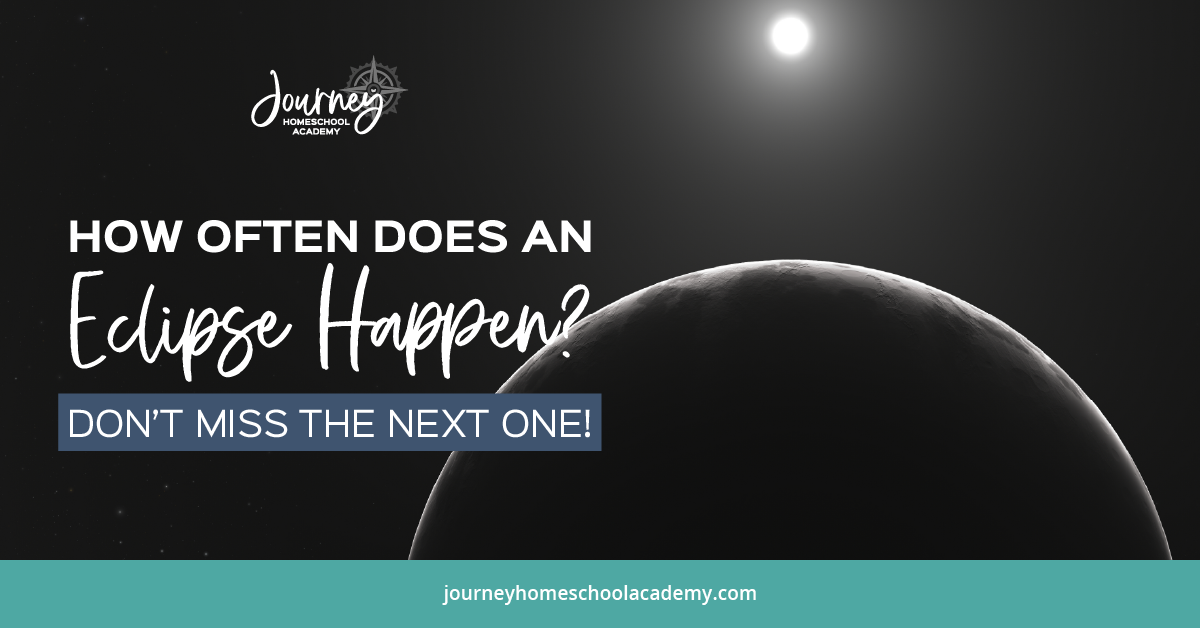Although eclipses have no physical effect on humans and our daily life, they have played a huge part in astronomy and new discoveries about the earth, sun, and space. Not only that, but if you have ever seen one, they’re just downright cool to observe! So, how often does an eclipse happen? Let’s find out so you don’t miss the next one!

But First, What Is an Eclipse?
When talking about eclipses, astronomers are generally referring to solar eclipses. A total solar eclipse occurs when the moon passes in between the sun and the earth, completely blocking the sun. The result on Earth is a very dark sky because of the moon’s shadow that casts on the earth as a result of this “blockage”. Although the sun is much bigger than the moon, it is extremely far away, which means that the moon can successfully block the sun when aligned with it.
It’s important to note that a total eclipse cannot be viewed by every region of the earth. So, while you might be able to view a total solar eclipse where you live, a person in a different country may view it as a partial eclipse. We’ll talk more about how you can view an eclipse based on where you live, so keep reading!
Other Types of Solar Eclipses

In addition to total solar eclipses, there is also a phenomenon called a partial eclipse. During a partial solar eclipse, the sun, earth, and moon are not in total alignment, but the moon still covers a portion of the sun. This means that only the partial outer shadow (called the penumbra) of the moon is cast on earth.
Let’s not forget about annular eclipses! An annular solar eclipse is like a total eclipse, but with one important difference. During this eclipse, the moon is at or near its farthest point from Earth. Thus, the moon looks smaller than the sun and cannot appear to cover the sun completely. For viewers, the moon will look like it has a glowing ring around it. That glow comes from the sun, of course!
A final but much less popular type of solar eclipse is the hybrid eclipse. Occurring only a few times per century, this eclipse is a wild combination of annular and total eclipses. Because eclipses cannot be viewed in every area of the earth at the same time, you will never be able to view both the annular and total part of a hybrid eclipse; it will either be one or the other depending on your location.
Lunar Eclipses

Before we move on to talk about how often eclipses happen and where you can view them, we need to discuss lunar eclipses. What is a total lunar eclipse? Well, in contrast to a solar eclipse, a total lunar eclipse occurs when the earth moves in between the sun and the moon and thus casts a shadow onto the moon. Total lunar eclipses can only occur when there is a full moon, but they are much easier to safely view with the naked eye than a solar eclipse.
During a total lunar eclipse, the moon will have a reddish tint to it. This is commonly known as a “blood moon” and is certainly a sight to behold! In fact, in 1504, the blood moon from a lunar eclipse saved Christopher Columbus and his men!
Although total solar eclipses can only be viewed from certain areas of Earth, total lunar eclipses can be viewed by anyone with a night sky above them. In addition, lunar eclipses can last a couple of hours, while solar eclipses last for only a few minutes at most (this is because the shadow of the moon is smaller than the shadow of the earth).
Less widely known than total lunar eclipses are the following forms of lunar eclipses:
- Penumbral lunar eclipse (only occurs a few times per century)
- Partial lunar eclipse (occurs a few times per year)
- Central lunar eclipse (occurs a few times per decade)
A penumbral lunar eclipse occurs when the moon passes through the earth’s outer shadow (penumbra). In a partial lunar eclipse, the moon passes through the earth’s inner shadow (the umbra). And finally, during a central lunar eclipse, the moon passes through the very center of the earth’s shadow.
How Often Does an Eclipse Happen?
And now, for the fun part! In order to observe a solar or lunar eclipse, you’ll need to know when one is actually going to happen. Fortunately, thanks to the work of scientists and modern technology, the timing of eclipses can be easily predicted and are highly accurate.
On average, a total solar eclipse occurs every 18 months. Annular solar eclipses occur around once a year. You may find it interesting that there are always at least two solar eclipses per year, but there can never be two total eclipses in a year. So, the minimum of two yearly eclipses must be a combination of total, partial, annular, or hybrid eclipses.
Important note: Solar eclipses should NEVER be viewed with the naked eye. Sunglasses, binoculars, or a telescope are NOT safe ways to view a solar eclipse. You should ONLY use solar filter glasses like these or make your own viewing box.

Like a solar eclipse, there are an average of two lunar eclipses per year, but oftentimes there are more than that. Blood moons, which are a result of total lunar eclipses, only occur every three and a half years or so – you definitely won’t want to miss that, so mark your calendar now!
This website offers a detailed table of past and upcoming solar and lunar eclipses and where they can be best viewed. It also shows a graphic of what you can expect each eclipse to look like. The viewing areas are very specific, so be sure to check the location of the eclipse before pulling out your binoculars or purchasing your solar glasses. If you are able to view the next total solar eclipse, do it! It is truly an incredible thing to experience (with your eclipse glasses, of course!).

Learn More About Eclipses with Experience Astronomy!
Solar and lunar eclipses are just the tip of the astronomy iceberg. There is a never-ending wealth of knowledge that astronomers are discovering about the solar system. At Journey Homeschool Academy, our astronomy curriculum, Experience Astronomy, offers a video-based learning experience that will be sure to expand your student’s appreciation for the sky and the stars.
Included in Experience Astronomy are:
- Weekly (fun!) video lessons
- Dozens of hands-on activities like this moon phase science experiment
- Engaging reading lists
- Supplemental retention material (copy work, memory work, quizzes, exams, etc.)
Eclipses leave us in wonder of the night sky and all it entails, and Experience Astronomy will only increase this wonder. We love the world of space, and your student can too!
